#and the thematic evolution of adventure time
Explore tagged Tumblr posts
Photo

what do you think the jigglers Career is. like they established all the man wants to do is sing and dance and then in the finale they gave him a suit and a briefcase and i guess we should be happy for him??
ron james: oh jiggler i just don’t vibe with this debt i’m in
jiggler: (inhales all the words off the page)
jiggler: 🎵 ron james: EY!!!
#points directly at u. i have thoughts about this. not about this comic but about the whole fact that hes in a suit and tie#and the thematic evolution of adventure time#BUT THATS BESIDES THE POITNTTT#adventure time#jiggler#ron james#traditional
12 notes
·
View notes
Text
gamers help me world build. the general genres are horror, speculative biology & shouldn't have gone there.
the generalized idea is a fantasy world that's not rlly all that different from ours, but magic and different creatures are an accepted and mundane part of life. the cast is a pentuplet of 3 researches / 1 adventurer / 1 body guard that are tasked with exploring a newly opened passage in the belly of a cave that seems to have tapped into a wholly new network with some very pronounced... oddities.
this network has been sealed off for milennia and has fostered an ecosystem entirely unique to itself. I'm rlly going for deep sea evolution vibes; half the critters are blind and go by hearing, vibrations or scent, the rest use some manner of bioluminescence to communicate in the dark. some fat lazy reptiles that stick to the walls and barely move or react, some semi aquatic, at least one carnivore w plenty of detritivores...
the plants have evolved over time their own brand of bioluminescence to attract the lower rungs of the food chain to themselves and so when they first arrive it's like breathtakingly beautiful and alien. just really bizarre and pretty and they're setting up camp right at the mouth of this juncture so they can make trips in without setting up entirely within the network.
the horror elements coming in with a specific type of fungus that strikes up like a cyan match underfoot and lets out clouds of glowing spores. they don't think too much of it but over the weeks to come they're going to be changed by it in really grotesque ways, I think. (and perhaps see this happen at a much faster scale to small critters with morbid realization).
glowing veins and bones and rotting, eventual blindness as the fungus grows over the wet surface of your eyes, yeah, but maybe it has almost rabies like effects where they become extremely photosensitive and claustrophilic, finding further, more narrow passages to cram into to better spread the fungus.
I've considered a lot of other horror angles to go with it too, like beginning to hallucinate pretty potently and becoming aggressively distrusting of their companions. maybe the body guard even kills one of the party and they scatter after that. a final girl moment where one of the researches has managed to stay safe but in her final escape attempt she hits a patch and realizes if she goes aboveground she'll only be spreading this beyond the passage, & so with the last vestiges of her autonomy she tries to seal it back in...
the types of plants, fruit, flowers, critters, etc... those are what I really want to dig into tho. the stuff they'd be researching and learning about. I haven't had a whole lot of ideas on what to use yet but anyone who does have thoughts send it to my inbox. 👀
restrictions are primarily nothing too big, and nothing that burrows. I think burrowers would have been discovered significantly sooner? so let's stay contained to preexisting tunnels. definitely got plenty of groundwater, springs trickling down the walls and pooling in flooded passageways etc. otherwise I don't have a lot of ideas yet!
also open to discussing the party. I think the final girl will be a magical researcher who's that clumsy kind of determined. the adventurer being any kind of smaller race (do I even want to use traditional fantasy races? idk!) and the body guard being the largest amongst them and by far the physically strongest.
thematically the horrors of spelunking at all, hypothermia being a constantly offset issue leading to paradoxical undressing as the fungus overrides basic control, stripping the last of your dignity and humanity, how prolonged darkness convinces you you can see (even after, say, fungal nodes have overtaken your eyes), no shortage of auditory hallucinations bc the white noise of trickling water is all you'd ever hear, the body guard becoming a very great threat after killing the adventurer, having become extremely hostile in response to the fungus.. u get the picture.
43 notes
·
View notes
Text
Ace Attorney game parallels (no, not that one, or that one, or that one ...)
One of the interesting things about the Great Ace Attorney in the evolution of Shu Takumi's Ace Attorney games is the maturation of "Weird Girl Assistant".
Our original trilogy Weird Girl Assistant is Maya Fey (obviously a perfect being beloved by everyone with taste why can't I preorder that Nendroid yet motherfuckers?), who is all heart and ... not so much knowledge, but a conduit to Mia’s knowledge. She doesn’t personally possess any legal knowledge, but she’s integral for Phoenix in accessing knowledge that would otherwise be denied to him due to Mia’s untimely death. She’s fully Weird in her Assisting.
Apollo Justice has Trucy Wright (obviously a perfect being beloved by everyone with taste), who is a lot of heart but not all heart. She has personal knowledge to impart to Apollo, regarding the perceive ability and his bracelet. It’s integral assisting to how the trials in that game will reach pivotal points, which makes it genuine Assisting, even if outside of that Trucy is plenty Weird. I would argue this is distinctive from the Phoneix-Magatama matter in the original trilogy (it’s easy to forget that Nick doesn’t even have the magatama in the first game) because Trucy is, essentially, teaching Apollo to do something he technically can already do, whereas the magatama is something Phoenix is given by an outside source still connected to the mentor (Pearl). Narratively and thematically they’re different, even if mechanically they function similarly.
Years later, the Great Ace Attorney gave us Susato Mikotoba (obviously a perfect being beloved by everyone with taste). Susato is an /actual trained legal assistant/ to the point she can masquerade as a lawyer in the second game's tutorial. She could BE the lawyer as easily at Ryunosuke, save for her sex in the historical setting of the game. She Assists like no one’s business and her Weird is no weirder than Ryunosuke himself, two young people who grew up in a country with recently opened borders, in a foreign country for the first time.
A reflection of a maturation in Takumi's depiction of female characters, a general wider consciousness of feminism in popular culture in Japan (something I am in no way qualified to discuss), a third possibility? I don’t think it’s fair or accurate to say that the evolution of the Weird Girl Assistant into an actual competent assistant is a sign of the games ‘maturing’. For all their goofiness there has always been a serious, darker tone in the games compared to the adventure game standbys of North America. It’s built into the series from the choice to have Phoenix’ second case involve the solving of his boss and mentor’s murder.
There may also be something in the connection between the tutorial mentor and the Weird Girl Assistant, holding the balance of knowledge between them like the centre of a seesaw.
The connection with Mia and Maya is obvious: they’re sisters and perfectly mirror each other in their relation to what they bring to Phoenix. Mia on a pedestal of legal knowledge, forever older and wiser than Nick, as her death fixes her on that pedestal. Mia and Nick never get to be colleagues, equals. On the other end, enthusiastic but underage Maya, someone Nick will always be older than and always be wiser than in the legal sense. We don’t know how an older Maya might have fit with the disbarred Phoenix Takumi left the series with; maybe it didn’t matter and outside the confines of the Lawyer Protagonist and Weird Girl Assistant, Maya could stop being a mirror for her sister.
Similarly, Kazuma and Susato are sibling-like. Kazuma, like Mia, is the tutorial mentor, but he’s only a mentor to Ryunosuke because he’s a law student and Ryunosuke isn’t. He doesn’t have that much more knowledge than Ryunosuke and I think it correlates that he doesn’t have that much more knowledge than Susato, the girl who expected to be his legal assistant. There is something like equality here between the Mentor and the Weird Girl Assistant when neither precisely fits their role mold. Kazuma is, I think, as weird as Susato is knowledgeable.
BUT WHAT ABOUT --
Bitch, you know I've always got Apollo Justice opinions to drop.
In Apollo Justice, Kristoph is a fully knowledgeable mentor to Apollo. He is an actual lawyer, he is Apollo’s senior, and he is Apollo’s employer. In these ways, he is on all fours with Mia.
Aside from being the murderer.
There is, frankly, an entire other thing to get into with the tutorial mentors and how their stories intersect with death and a turning point in their respective protagonist’s life and career but this is about Weird Girl Assistants.
So.
What is Kristoph Gavin’s Weird Girl Assistant connection?
THE INCIDENT.
Seven years earlier, in Zak Gramarye’s trial, Trucy is used by Kristoph to deliver fake evidence to Phoenix, leading to Nick’s disbarment.
In Apollo’s tutorial trial, for the murderer of Shadi Smith/Zak Gramarye, Trucy is used by Phoenix to deliver fake evidence to Apollo, leading to Kristoph's arrest (and possibly his disbarment but who knows in the world of Ace Attorney and Japanifornia).
I have nothing but love for Trucy, but she's the shifty, deceitful Weird Girl Assistant to follow a shifty, deceitful Tutorial Mentor in a game about disillusionment and broken trust, following a trilogy about believing in yourself, your instincts, and redemption, and preceding two games riding a balance between hope and despair, with part of that balance being a more equal partnership between the Attorney and his Weird Girl Assistant.
#ace attorney#apollo justice#the great ace attorney#parallels#narrative patterns#just talking about ace attorney again#i have an advanced honours degree in saying how one thing is like another thing
472 notes
·
View notes
Text





Karpe Diem
It's that time of year again... Karpe Diem!
The famous festival of the Joisey region which brings travelers from far and wide to compete in a fishing competition overseen by the widely adored Mayor Slowpoke. Set out on adventure to become the next Karpe Diem champion, face off against a worthy rival, meet helpful strangers, and solve thematic puzzles.
This fan-made Pokemon slice of life game strips out longtime series mechanics such as battling, badges, and evolutions to instead focus on things like kicking back, relaxing, and reeling in a whopper.
16 notes
·
View notes
Text
SPOILERS AHEAD FOR D20′S NEVERAFTER
(This was started the weekend after the finale, then my spoons ran away for awhile. -_-; Hopefully this is coherent anyways, even if late.)
I have been...struggling with this season of Dimension 20. As we’ve gone from episode to episode, I keep coming back to the issue of foundational rules – not in the sense of mechanics of world-building, but the thematic underpinnings and models. You’re telling a story about stories. We have these elements of horror and free-will; themes of consumption and corruption; cycles and multi-verses.
And I haven’t been able to tie it all together. My metaphorical wall-chart of photos and string has been an unending tangled mess (and my brain staunchly refuses to stop fixating on Aesop’s Mouse and Lion, aka the mascots of Disney and MGM so obviously that’s been a heel-turn of Capitalism waiting to happen >_>). After the finale I just sat there blinking for a bit, feeling like that certainly was a thing that had happened, but what did it all MEAN?????
There wasn’t anything that felt wrong with what happened, but there wasn’t any narrative logic I could grasp, no themes to tie things together other than “things are better now and what people chose for themselves” which is...nice, but vague enough to be unfulfilling. I couldn’t find anything to the Adventuring Party episode to help, so in growing frustrating I went browsing through the related tags on the tumbls.
This deceptively simple post broke me because it explained matters so well. It’s trauma. The whole season, all the horror and meta themes are about trauma. Suddenly all the oddly shaped puzzle pieces I couldn’t stop pawing at fit.
This is why the dark times began in the first place. People worried so much about trauma that they managed to traumatize themselves. Look how Sleeping Beauty’s vines literally smothered her in an attempt to protect her. All these population centers withdrew from each other, borders closed between the various kingdoms, and thus people pulled away from the potential for community support – everyone was left to struggle and fall on their own.
It wasn’t what I originally thought, some nebulous fear of fear itself inevitably leading to the darkside nonsense, but instead how we isolate ourselves into our little echo chambers – each person caught up in their story and their story alone. How we become mired in those events/trauma until one’s entire life is framed around That Horrible Thing What Happened At One Point In My Life.
Which in turn addresses the Authors – as a storyteller myself, I was mighty uncomfy with the presentation of the Authors as a unified bloc of uncaring eldritch horrors from beyond that only wanted the suffering of their playthings. I couldn’t figure if I was picking up on the wrong vibe, or if this was one of those learning moments where “if you’re uncomfy that might be ‘cause it hits too close to home and you need to sit with that for a bit to chew it over” or whatever. With the trauma context, it makes sense. On the one hand, the Authors are the external force: just like the characters, they’ve been corrupted by the fear of the Dark Times, and thus spreading that to their creations, which spread it back to them, etc. On the other they are very much an internal force: when we are traumatized, we tell ourselves stories to contextualize what happened. That can be done in a healthy way – this is one of the reasons we tell stories to begin with – or one can become mired in that narrative, telling and retelling it while fixating on the worst parts (that fear of the Dark Times thing again) until all that one sees is the worst iteration.
Which is why there was the multiverse aspect, and why each one could/did get worse. For that matter, it addresses the evolution of Pib’s minis, which baffled me when they were revealed. He begins as the dapper rogue, then becomes the hardened stray, then the scared little cat. Trauma wears at people, and oftentimes the immediate reaction is to withdraw, to be emotionally distant and appear tough – Rather like Zac’s choices on how Pib changed between incarnations. From there its so easy to get ground down further, into something so tired and hurting that it’s difficult to expect anything other than to be hurt further. Or look at Rosamund, increasingly isolated by her briars, which are choking her as they “lovingly” work to protect her from the big bad scary world – until she is puppeted by them.
Honestly, a lot of character choices make a lot more sense. Ylfa’s separation, how she believed that “the girl kept holding the wolf back.” The Stepmother’s everything, exemplifying that old saying about how “hurt people hurt people,” and a classic example of how easy it is to repeat generational trauma, especially when you don’t have a model for other ways to approach matters. The princesses’ utter nihilism, the exhausted desperation to just have the suffering stop. The fairies as the well-meaning but misguided faction endorsing placating the/a source of trauma to keep things from getting worse is all too familiar of those caught up in traumatic cycles but want to exercise some, any kind of autonomy. Meanwhile look at how Rapunzel grew able to lash out at literally everyone, and how she was utterly honest without ever needing to be truthful. How so many people just needed to rest in Mother Goose’s book, to get some reprieve from the relentless cycle of trauma (and how it helped them, and in return helped the party).
This explains the horrible Worst Case ending that was mentioned in the Adventuring Party: the Stepford Wives society of terrifying seeming-perfection crystallizing everyone into a semblance of how Everything Is Fine, Nothing Is Wrong, and no lessons are learned, no changes can be made, and the core is often rotting away unseen. All too often, society pressures us to pretend trauma didn’t happen, or that it wasn’t so bad. (How many times have you heard that PTSD is only for military folks, or those who survived massive natural disasters or whathaveyou?) The lesson we internalize is to pretend that all is peachy-keen, no problems whatsoever, and when that happens the trauma is never addressed. One can’t heal if all your energies are devoted to keeping up the facade of an idyllic existence. To be stuck in that cycle is indeed pretty apt for the worst end of a horror season.
Of course, this leads to the big question: what makes the players different? HOW did they manage to break the cycle? By literally crafting a new narrative – by allowing EVERYONE to make their own, new narrative, to shed the weight and burden of generational trauma. Some of them, like Pinocchio, had already internalized their own story – in his case, that meant taking up the terrifying responsibility of autonomy, taking up his own strings and destiny. Pinocchio learned and understood his story, stepping forward to not be ruled by his past experiences – like Gerard, choosing to leave his humanity and stop chasing the old goals that everyone said he should desire. Even though they both grieved the loss of that goal, and all the ramifications of leaving those hopes behind – even as it meant accepting the scars and changes it wrought upon them – it helped them and others in their stories break out of the cycle of trauma.
Stories are doorways to other places – sometimes a temporary haven in someplace better, where no matter how bad things get, there is a ‘happily’ at the end of it. Sometimes they’re models of how things could be horrible, and we can learn how others deal with grief/tragedy/horror – so we in turn can acquire those skills and life lessons. Vicarious experiences can help mitigate/understand trauma, and somehow, without me even noticing it, this season leaned wholeheartedly into it.
I think I need to rewatch it all through that lens, and tbh? I’m looking forward to it.
#dimension 20#d20#neverafter#neverafter spoilers#spoilers#meta#analysis#thinky thoughts#stories#story telling#trauma
97 notes
·
View notes
Text
I've been going over my thoughts on all the aquatic Digimon. Previous posts here: all fish, all mermaids, and aquatics part 1. Since I've gone over the aquatics with a default evolution line, today I'll just go over all rookie/child, champion/adult, and armor level mons that I haven't already discussed.
I will say that my previous post's analogy on how Digimon evolution works was not at all helpful, so I'll try again. Digimon evolution is branched, where each stage has multiple possible next stages that do not necessarily need to have a thematic connection to prior stages. Stages are not mutually exclusive and separate Digimon can evolve into the same thing. Digimon can also evolve backwards and not to the same thing they started as. For example, an Agumon (little dinosaur) can evolve into Centaurumon (centaur), then evolved back down to a Patamon (winged hamster). The animes usually simplify things from the games and virtual pets by giving their Digimon characters much more linear and thematically consistent evolution lines. I may do an intro to Digimon post some day.
Starting with rookie/child levels we have an old mon that hasn't been used much: Gizamon. It's been around for a long time, but rarely gets any attention and as far as I can tell, has never gotten a spotlight, even as a monster of the week. That's too bad, it's a neat little critter. It's a marine mammal, but has the body shape and jumping ability of a frog.
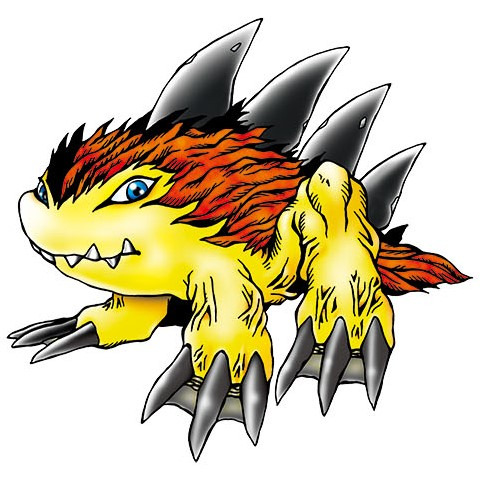
Next up is Crabmon (Ganimon in Japanese). People compare Pokemon and Digimon a lot, but one comparison I haven't seen is that they both made a monster that's literally just a crab. Crabmon and Kingler are both fiddler crabs too, with one much bigger claw. I like it and there are a few crustaceans of higher level that I think could be a good pre-evo for. Crabmon also has a x-antibody variant.
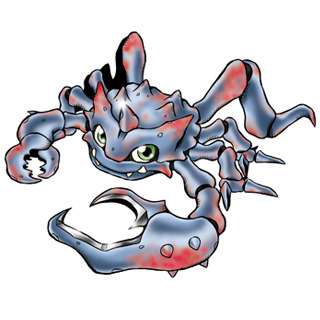
Crabmon
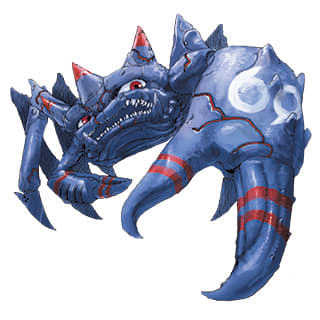
Crabmon X
The last of this level is Sangomon, a very new Digimon. I love it so much, it's a little staghorn coral monster with polyps for arms. It's so cute and such a creative way of making coral as a monster. I wish it has a full through-like of coral reef evolutions. If I had to pick any of the rookie/child Digimon form this series as a partner, it honestly might be this one.

Moving onto the champion/adult level is Ebidramon. Ebi means shrimp and dramon indicates that the Digimon is draconic, so it's a shrimp dragon. It clearly isn't fond of shrimp being used as a synonym for tiny as it will attack those who make fun of it.

Next is Gesomon, which clearly takes ofter humboldt squids as its very violent and scary. It attacks those who enter its territory, but won't bother those outside of it. It's also very intelligent and cunning, which is very appropriate for a squid. I really like Gesomon, I think it's a great choice for an evil aquatic line. Gesomon has an x-antibody variant which is incredibly ugly and not in a good way. Its ugly in an "I don't want to look at this any more" way.

Gesomon
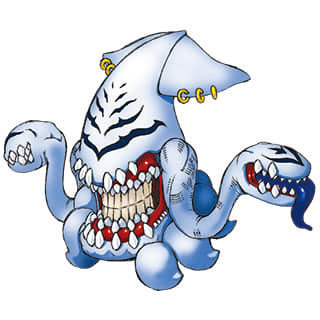
Gesomon X
The last aquation at this level is the excellent Octomon. I don't like any of the octopus Pkemon very much and Digimon deliverd for me. It's a kleptomanian who wears a pot for a head much like how a coconut octopus lives inside coconuts and other hard objects. The crown came from a sunked treasure chest and that gun squirts ink. Weirdly enough, the little gold barnacles on it are identified as another Digimon called Fujitsumon and Octomon's reference book entry is the only place Fujitsumon has ever been mentioned.
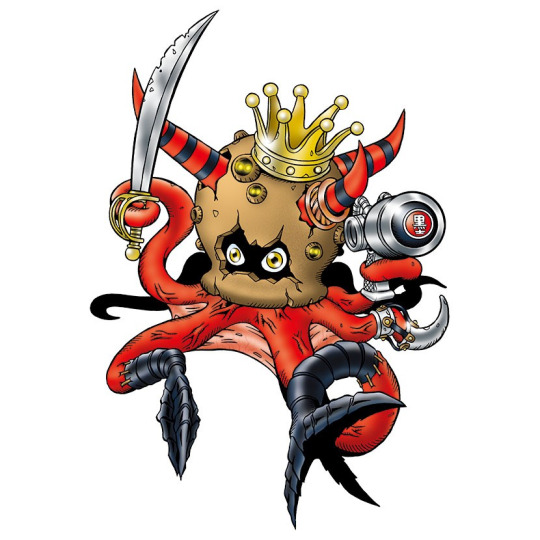
Next up is the armor level, which lies outside the normal evolution levels. It was introduces fro the anime Digimon Adventure 02 and outside of media related to that show, armor Digimon are often treated as being synonymous to the champion/adult level.
First is Archelomon, a sea turtle with knives for flippers. Digimon has had much more ridiculous designs, but for some reason this one seems over the top for me.
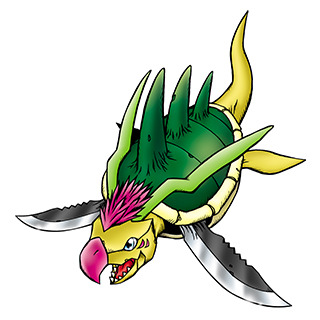
Next is Depthmon, who absolutely should have been in the mermaid post but I forgot about it. I really like this guy, a merman wearing a diving suit. The suit lets it dive way deeper into the ocean than most Digimon because it can endure incredibly high pressure. Armor Digimon are the result of a Digimon evolving with an object called a Digimental that represents some virtue like courage. The anime only used a few combinations and a lot of the official armor Digimon are the result of filling out the other matches. For example, in the show, Veemon/V-Mon used the Digimentals of courage and friendship to become Flamedramon and Raidramon respectively. Depthmon is one of the unseen combinations, Veemon plus the Digimental of sincerity (reliability in the dub). The unseen combinations don't get nearly as much attention as the ones that did appear in the anime, which is a shame because some of them, like Depthmon, are pretty cool.
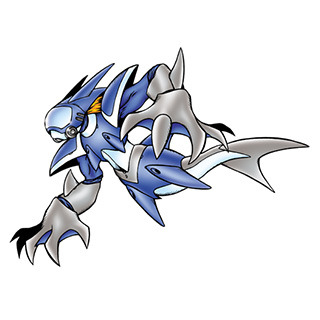
Next is Orcamon and I absolutely love this goofy beast. An Orca life guard is such an exceptionally silly concept executed quite well. It actively rescues other Digimon that are lost at sea. Orcamon seems like a good friend. What's even better is that it was designed by a fan as part of a contest. That fan has some great ideas.
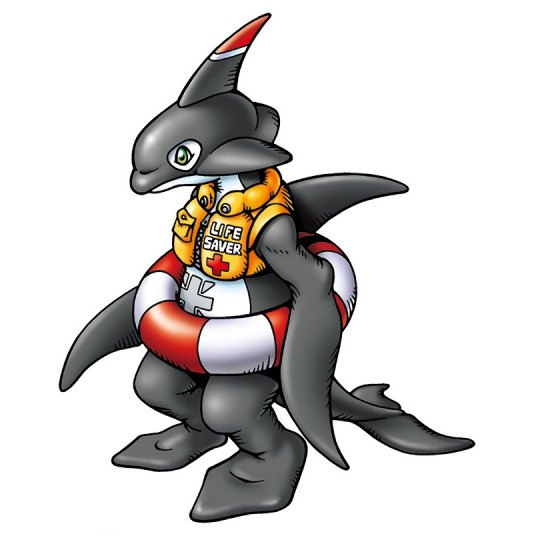
Next is Submarimon, which I probably could have justified in the fish post. Its a fish-shaped submarine of course, but that harpoon nose also makes me think of sawfish. This is one of the armor Digimon that appeared in the anime where it was a bit underutilized due to being strictly aquatic. Fortunately the writers seem to have agreed because it got to appear in some of the other anime seasons as an ally.

Finally we have Tylomon, which is a tyloaurus, a type of prehistoric marine reptile. I like marine reptiles like mosasaurs, so Tylomon is pretty cool to me. It also has an x-antibody variant which is a classic overdesigned form. It's kind of weird that some of the more obscure armor Digimon got x-antibody forms befrore the ones that showed up in the anime, but I'm all for more obscure mons getting more attention.

Tylomon
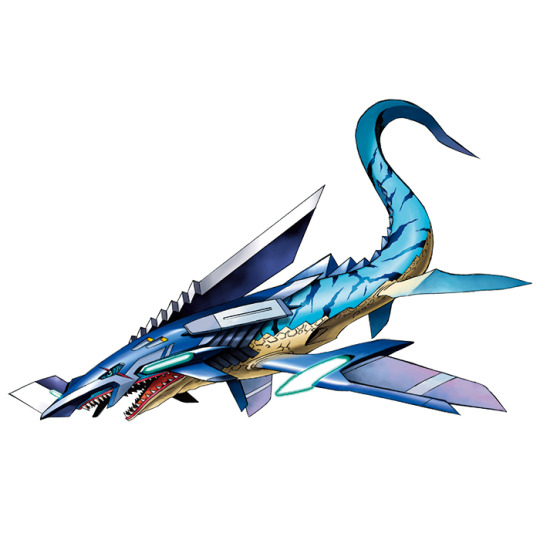
Tylomon X
That's it for today. Next post will finish up the aquatic Digimon with the ultimate/perfect and mega/ultimate levels
#digimon#aquatic#aquatic animals#gizamon#crabmon#ganimon#sangomon#ebidramon#gesomon#octomon#archelomon#depthmon#orcamon#submarimon#tylomon
32 notes
·
View notes
Note
OHHHH bingo time
The Bishop of St. Fiacre's or the Youthful Naturalist (so far)

i'm gonna be honest, the bishop is probably the heart's desire character i think about the least? he's fine, he's good, i like his energy, i just don't know much about him. he seems like an alright guy. the immortality thing is interesting thematically when paired against the bandaged scoundrel. not a guy i'd put as a top tier FL character but like he's a solid respectable B. also apparently he's a snuffer which i literally only just learned from the lore wiki hello hey what?

the naturalist on the other hand is a GOOFY fucking guy and i love him so much. what the fuck is Wrong with him. he's waiting on the scoundrel to meet him at godfall with a key lodged in his spine and they went on some biblical body horror grotesque nightmare adventure together and he's absolutely insane. cannot get enough of this guy. i need to dissect him like the tomb colonist that one time. literally nothing could prepare me for just how unhinged he is 24/7. in a rare display of personal temperance i actually haven't spoiled myself on the endings to evolution and im steadily growing more and more concerned for his safety im ngl
#my perception of fallen london is probably significantly altered by me pointing to unrelated things#like they're some sort of thematic connection to the scoundrel's personal entirely headcanon character narrative#when they're all just like. things That Are In Fallen London#ask#fallen london
10 notes
·
View notes
Text
Styrax Dev Diary #3: Me and U(I)
Back during the first iteration of Button Man-- back when it was strictly a point and click adventure game via Adventure Game Studio-- the UI needs were fairly 'find and replace'. Point and Click Adventure audiences are not averse to change per se, but over the 40 year lifespan of the genre, some standards were expected. A semi-diegetic inventory screen which swipes into and out of shot, a cursor which changes shape or accompanying icon according to context, and a dedicated text description area for showing the names of objects/characters the player's cursor hovers over. But since the beginning, we also knew we wanted combat in Button Man. As a new team, the combat existed in a sort of theoretical space, which we would 'get to when we get to'. Pretty quickly, we got to it. So we started with a semi-turned based system, with icons surrounding the player which you would press via mouse click. Punch/ Block/ Use Item. But our ideas started to flow, and the combat became more interesting and intricate, but also became more... unrelated? It's one thing to marry Point and Click trappings to a modern combat system, but its another to require a whole new control scheme and frame of mind when switching between the two modes. But how to solve this combat conundrum? Coincidentally, for reasons I may get into another time, this moment of head scratching was followed by the first major shift in development: Side Scrolling.

The place where games are (sometimes) made You see, also at the start, the story and thematic elements were pretty set-in-stone. But what we did not have was a standardized art style. Much of the early artwork was strictly practical; a bench was a bench, there was no specific style applied. The breakthrough was the decision to establish an old pulp-comic style, in the image of Smilin' Jack and TinTin. With that style, it began to make sense to change the visual angle a bit, which in turn made a restricted horizontal movement style make more sense.
With that, we realised it also made more sense for the player to explore the world a bit more directly, via keyboard controls. WASD/Arrow key movement would add a sense of tactile immersion (you know, as far as these things go with a keyboard and a named character on screen).
And with THAT revelation... we arrived at the obvious answer for our combat-- Beat 'em up side scrolling. It fit perfectly with our protagonist, Bruce McKenzie, who is a former junior boxer and all around tough guy, and comics have no shortage of "BAM", "POW!", and "SMACK!" images called to mind. With a change to artwork and keyboard controls, the migration to a side scrolling adventure game inspired by point and clicks was complete.

Original Bruce, followed by the first pass at a comic Bruce.
Which brings me to the present moment. The road to the current look and feel was long and winding, as the Lead Designer (me) learned 3 separate engines during this time and spent a good portion of the last year trying to catch up to our Lead Developer's abilities and knowledge of Unity. I'm happy to report that I am competent and comfortable in the Unity environment now, but that means I'm now sweeping up after myself in the wake of all the education. So many factors and components were created as temporary measures; placeholder dialogues, placeholder location teleporters, placeholder animations, and placeholder UI. All of these components have had their own evolutions and iterations, as I learned what we are capable of producing. We now have an elegant character teleportation system, and excellent Dialogue Manager which is overloaded with functionality, and now its time to fully shift the UI away from the Point and Click to one befitting a side-scroller.

what a lovely gait
First and foremost, our artist, Sam Mameli, worked hard to make the locations look great-- lets not hide them with bulky, persistent UI elements! Today I am creating the animations to hide away icons when not in use.
We've also removed the Description bar from the bottom of the screen, which tells the player who or what they are about to interact with.

Instead, the interactable which the player is about to activate will animate or highlight, allowing the player to plainly see that they are going to speak with a character, for instance, without revealing their identity.
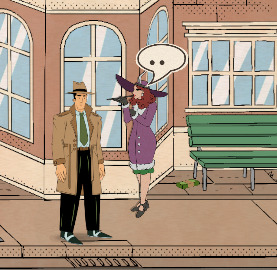
Next up, I'll be shifting our dialogue box from the wide format, bottom of the screen style, to one which emerges from the right side of the screen, creating a square on the left side of the screen in which to center the conversation. This means that the camera will have a clean, unobstructed view of the characters and the backdrop.

(The background artwork is outdate in the above image, but you can see the UI components which are about to be updated)
I hope to finish this all up in the next few days, so that our artists can go in and replace the placeholder artwork sooner than later, bringing Button Man one step closer to being Gamescom ready!
2 notes
·
View notes
Text
"Embarking on Enlightenment: A Journey through 'Initiation into Philosophy' by Émile Faguet"
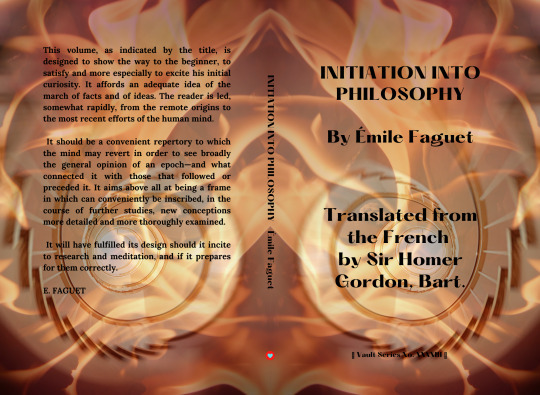
Émile Faguet's "Initiation into Philosophy" serves as a captivating portal into the world of profound ideas and intellectual exploration. This literary gem not only educates but also enthralls, making the initiation into philosophy a thrilling adventure.
Faguet, with eloquence and insight, navigates the intricate landscapes of philosophical thought, presenting complex concepts in a manner accessible to both novices and seasoned philosophers. The book invites readers to ponder the fundamental questions that have shaped human understanding for centuries, sparking a delightful intellectual curiosity.
One of the book's strengths lies in its ability to demystify philosophy, transforming it from an abstract discipline into a vibrant and relevant exploration of life's most profound inquiries. Faguet's narrative style is both engaging and thought-provoking, creating a harmonious balance between scholarly depth and reader-friendly accessibility.
As readers traverse the pages, they encounter a rich tapestry of philosophical traditions, from ancient wisdom to modern theories, each contributing to the mosaic of human thought. Faguet masterfully weaves together key philosophical tenets, offering readers a panoramic view of the discipline's evolution while highlighting its enduring relevance to contemporary life.
The book's thematic organization allows for a seamless journey through the realms of metaphysics, ethics, and epistemology, providing readers with a comprehensive understanding of philosophy's multifaceted nature. Faguet's insights into the works of notable philosophers add a layer of richness, transforming the book into a guide through the intellectual lineage of great thinkers.
"Initiation into Philosophy" is not merely a book; it is an odyssey that beckons readers to embrace the joy of intellectual discovery. Faguet's prose invites reflection, prompting readers to question, contemplate, and savor the intricacies of the philosophical landscape.
In conclusion, Faguet's "Initiation into Philosophy" is an intellectual feast that transcends the boundaries of time. With a captivating blend of erudition and accessibility, the book stands as an enduring testament to the timeless allure of philosophical inquiry, making it a must-read for anyone curious about the profound mysteries of existence.
Émile Faguet's "Initiation into Philosophy" is available in Amazon in paperback 12.99$ and hardcover 20.99$ editions.
Number of pages: 191
Language: English
Rating: 8/10
Link of the book!
Review By: King's Cat
#Philosophy#Émile Faguet#Intellectual Exploration#Philosophical Inquiry#Metaphysics#Ethics#Epistemology#Intellectual Curiosity#Great Thinkers#Human Understanding#Ancient Wisdom#Modern Theories#Thought-Provoking#Scholarly Depth#Thematic Organization#Philosophical Traditions#Existential Questions#Timeless Relevance#Profound Ideas#Intellectual Discovery#Book Review#Contemporary Life#Exploration of Life's Questions#Narrative Style#Intellectual Journey#Erudition#Reflection#Metaphysical Inquiry#Ethics Exploration#Intellectual Odyssey
4 notes
·
View notes
Text
UI design and Themes
UI sucks amirite. Since this game is an RPG, menus are one of the most important parts of the game since you’re gonna be seeing those menus a lot.
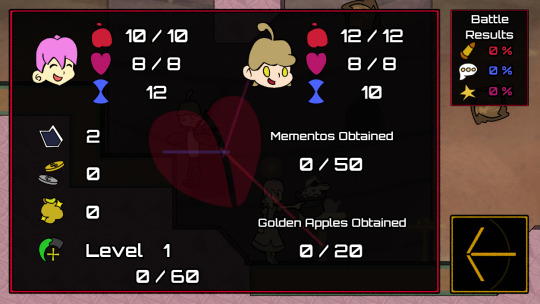
First is the functional side of things. Since in this game you need to aim your attacks, having to choose from a list menu then aim would mess with the flow so much. So, I made it so the transition from menu to aiming was seamless: a radial menu! Which also works thematically since now it’s a circular menu where you aim with your hands, like a clock!
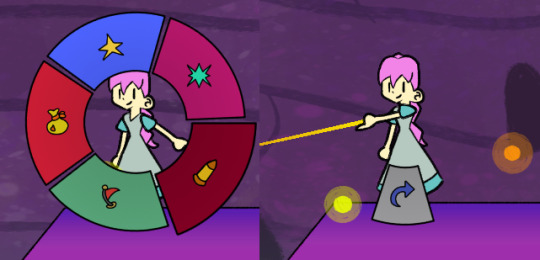
That’s the other part, the visual flare. Since I wanted the menus are so important, I wanted them to not be generic menus. That’s where the themes of the game come into place! If you design your menu as “just a menu” it will look like that, a boring generic menu. If you want to design something that isn’t generic, you must think of a specific idea.
So that’s why almost every menu is love, apples or time themed.
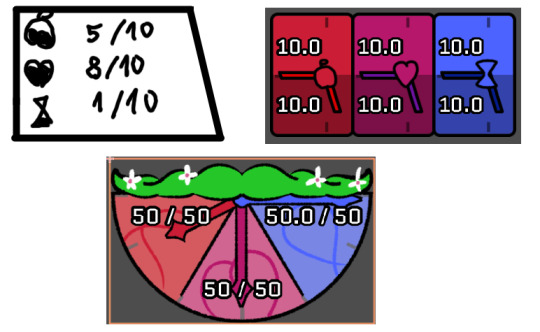
The HP bars? Clocks and some flowers to represent apples. The evolution for the idea, at different stages (The bottom one is the final one).


Same for the foes’ HP bar. Also a clock. The first version was clearer on that theme, but it was ugly sooo.

The Dialogue Box? Clock. I don’t have the old designs for it, but I know I designed a couple before settling into this.
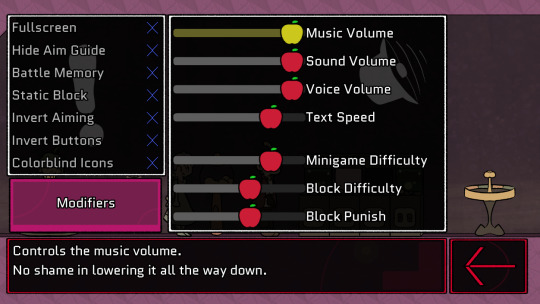
The options menu? Obviously apples. (And also the modifiers button? A polaroid. The back arrow? A Clock too.)
And so on and so forth.
So that’s my advice, I guess. Get a good theme and stick to it.
If you have a shallow theme the design will come out shallow, but if you have a very particular design theme it’ll come out unique. Maybe not good because , but at least unique.
The theme, of course, should relate to what you want your project to be. It doesn’t even have to be anything deep, at all, but you should have something.
Not to be mean, but I genuinely think that if your piece of art has nothing to say, has no themes to convey -even if those themes are as simple as “friendship”, “adventure” or whatever- I think you should reconsider. Thematic depth is not the opposite of fun and, at least to me, makes media much more engaging. Even if those themes are purely visual aesthetic. Even if those menus are just a clock hidden in every piece of UI.
If you want to experience the stupid apple menus, you can do so here.
#indiegame#paperverse#UI#the stats menu has a functional analogue clock#because I didn't know how else to fill the space#so I took that pic at around 9:00 PM
2 notes
·
View notes
Text

Rarely does a sequel live up to its predecessor, yet Arcane: League of Legends Season Two not only meets but exceeds expectations. This adult animated steampunk action-adventure series, created by Christian Linke and Alex Yee, continues its riveting saga with a flawless blend of character-driven storytelling, breathtaking visuals, and thematic depth. Produced by Fortiche under Riot Games and distributed by Netflix, the show cements its place as a titan in the realm of animated television. Season Two dives deeper into the League of Legends universe, focusing on the evolving, fractured bond between sisters Vi and Jinx while weaving intricate narratives of politics, betrayal, and survival. https://www.youtube.com/watch?v=ysqiEC6bLUI Narrative Prowess: The show wastes no time diving into the aftermath of Season One's explosive finale. The narrative opens with the chaos caused by Jinx's rocket attack on Piltover’s council, setting a tense stage for the season. Episode one, “Heavy Is the Crown,” establishes a somber tone as we witness the fallout of the attack. Jayce, Mel, and Viktor grapple with survival, guilt, and responsibility, while Vi and Caitlyn navigate their strained partnership in the shadow of personal loss. The show maintains its careful balance between high-stakes action and poignant emotional beats, ensuring every character arc feels earned and impactful. Season Two is a masterclass in world-building and character complexity. Zaun’s descent into anarchic civil war and Piltover’s burgeoning political corruption are depicted with brutal honesty. The show delves into the moral ambiguity of its characters, from Viktor’s transformation into a self-styled savior to Caitlyn’s increasing militarization under Ambessa’s influence. Each subplot ties seamlessly into the overarching narrative, creating a tapestry that is as intricate as it is compelling. Character Evolution: The emotional core of the season lies in the relationships, particularly between Vi and Jinx. Their dynamic, once defined by familial loyalty and childhood memories, has evolved into a devastating push-and-pull of love and betrayal. Jinx’s mental instability and guilt, portrayed with haunting precision, are amplified by her interactions with Isha, a young orphan who becomes a surrogate sibling. Vi’s journey, marked by grief, alcoholism, and a reluctant return to her roots, adds depth to her hardened exterior. Caitlyn emerges as a commanding presence this season, her promotion to Commander pushing her into moral grey areas as she wrestles with loyalty, love, and justice. Her relationship with Vi—equal parts tender and tumultuous—grounds the series amidst the chaos. Meanwhile, Viktor’s transformation is one of the most compelling arcs, as his newfound power and growing cult of personality highlight the dangers of unchecked ambition. Ambessa Medarda, a commanding and manipulative force, adds a fresh layer of intrigue. Her machinations drive much of the season’s conflict, and her relationship with her daughter Mel reveals the complexities of power and legacy. Visual and Technical Brilliance: Season Two takes the already stellar animation of its predecessor and elevates it further. Fortiche’s meticulous artistry shines in every frame, from the gritty streets of Zaun to the opulent heights of Piltover. The use of lighting and color continues to astound, with Zaun’s greenish haze and Piltover’s golden glow serving as visual metaphors for their respective societies. Action sequences are choreographed with balletic precision, each fight bursting with kinetic energy and emotional weight. The visual storytelling is complemented by an impeccable score. The soundtrack seamlessly blends orchestral grandeur with industrial beats, underscoring the show’s steampunk aesthetic. Character themes, such as Jinx’s erratic melodies or Viktor’s somber undertones, add emotional resonance to pivotal moments. Themes and Depth: Arcane doesn’t shy away from exploring complex themes. This season delves into the cyclical nature of violence, as Jinx’s descent mirrors Vander’s tragic legacy. The juxtaposition of Piltover’s technological hubris against Zaun’s desperate struggle for independence highlights socioeconomic inequalities. Themes of identity and transformation permeate the narrative, whether through Viktor’s fusion of humanity and machine or Jinx’s struggle to reconcile her fractured psyche. The series also tackles the ethics of power and progress. Jayce’s conflicted role as a Hextech innovator showcases the double-edged nature of technological advancement, while Caitlyn’s transformation into a militarized leader raises questions about the cost of justice. Standout Episodes: Several episodes deserve special recognition. “Watch It All Burn” perfectly captures Zaun’s anarchic state post-Silco, with Jinx’s deteriorating mental state juxtaposed against Viktor’s rise. “Blisters and Bedrock” offers a heart-wrenching exploration of Vander’s tragic return as a human-wolf hybrid, culminating in Isha’s emotional sacrifice. The finale, “The Dirt Under Your Nails,” delivers on every promise the season makes. It's truly an episode that you need to see to believe. And trust me, you'll need plenty of tissues. Overall: Season Two of Arcane is a triumph in every sense. It expands upon its predecessor’s foundation with a richer narrative, deeper character development, and unparalleled visual artistry. The series continues to push the boundaries of animated storytelling. It proves that animation can be as mature, complex, and emotionally resonant as any live-action counterpart. Whether you’re a die-hard fan of League of Legends or a newcomer to its universe, Arcane is a must-watch masterpiece. Season Two doesn’t just tell a story; it immerses you in a world brimming with beauty, pain, and unrelenting humanity. Read the full article
0 notes
Text
Which M Night Shyamalan Movie Reigns Supreme?
Which M Night Shyamalan Movie Reigns Supreme? https://www.youtube.com/watch?v=iDjK-HyfI3o Which M. Night Shyamalan movie reigns supreme? Welcome back, film fans! In this video, I’m diving into the world of one of cinema’s most intriguing directors—M. Night Shyamalan. From his early masterpieces to his latest works, I’m ranking the best movies of Shyamalan, exploring what makes each film stand out and how they contribute to his unique storytelling style. Join me as I: * Rank Shyamalan's Top Films: Find out which of his movies made the cut and where they land! * Analyze Key Moments: Dive into the most memorable twists, turns, and thematic elements. * Discuss Shyamalan’s Evolution: See how his filmmaking has evolved over the years. * Share My Picks: What’s my favorite Shyamalan film? Watch to see if you agree! Don’t forget to hit that subscribe button and ring the bell to stay updated on my latest rankings, reviews, and movie content! Drop your own Shyamalan rankings and favorite movies in the comments—let’s compare notes! 🔔Your weekly source for fun and honest movie reviews, movie trailer reactions, and so much more! Subscribe now. https://www.youtube.com/@ChatalbashReviews/?sub_confirmation=1 ✅Important Links to Follow 🔗Linktree https://ift.tt/uNSCQFX ✅ Stay Connected With Me. 👉Facebook: https://ift.tt/tgBcASe 👉Instagram: https://ift.tt/wvWbSjh 👉Tiktok: https://ift.tt/BuSAZ0y 👉Twitter (X): https://twitter.com/tomchatalbash 👉Letterboxd: https://ift.tt/zPQwbyL ✅ For Business Inquiries: [email protected] ============================= ✅ Recommended Playlists 👉 Movie Reviews (2023) https://www.youtube.com/watch?v=qVDfULnuTIo&list=PLXXW3Qpf_X2W-xzjVHcT45LmtHmOpM25U&pp=iAQB 👉 Film On Tap Podcast https://www.youtube.com/watch?v=bb2lOgpeL2w&list=PLXXW3Qpf_X2XCoxtsIxFaxZfo0B3PeSX2&pp=iAQB ✅ Other Videos You Might Be Interested In Watching: 👉 Nosferatu, Smile 2, Red One Trailers & A Quiet Place: Day One Review - Film On Tap Ep. 67 https://www.youtube.com/watch?v=eAWs7Parw8c&t=23s 👉 Despicable Me 4 Movie Review: A Fun-Filled Adventure Worth Watching? | Chatalbash Reviews https://www.youtube.com/watch?v=-8RVzwZovR0 👉 A Family Affair Netflix Movie Review - Honest Critique & Reaction | Chatalbash Reviews https://www.youtube.com/watch?v=0txDP6cL1bA&t=104s 👉 A Quiet Place: Day One Movie Review - Lupita Nyong'o & Joseph Quinn | Chatalbash Reviews https://www.youtube.com/watch?v=0YTQhpPsBLU 👉 Red One (Official Trailer) Reaction 2024: Dwayne Johnson & Chris Evans Movie | Chatalbash Reviews https://www.youtube.com/watch?v=vl9uIB9lFj8 ============================= ✅ About Chatalbash Reviews. In the 15 years I've been reviewing movies, I've learned two things. The first is that movies will always vary in quality and the second is that my last name is a branding nightmare. So why not subscribe so you never have to remember how to spell it? The added bonus is you'll get fun and honest weekly movie reviews, movie trailer reactions, and so much more! What have you got to lose besides your time? Wait... 🔔 Subscribe for fun and honest weekly movie reviews, movie trailer reactions, and so much more! https://www.youtube.com/@ChatalbashReviews/?sub_confirmation=1 ================================= #MNightShyamalan #BestMovies #FilmRanking #ShyamalanFilms #MovieList #Filmography #DirectorRankings #MovieAnalysis #ShyamalanTwists ⚠️Disclaimer: I do not accept any liability for any loss or damage incurred from you acting or not acting as a result of watching any of my publications. You acknowledge that you use the information I provide at your own risk. Do your research. Copyright Notice: This video and my YouTube channel contain dialogue, music, and images that are the property of Chatalbash Reviews. You are authorized to share the video link and channel and embed this video in your website or others as long as a link back to my YouTube channel is provided. © Chatalbash Reviews via Chatalbash Reviews https://www.youtube.com/channel/UCmqQebnXAVWe5OKEfVHfj2g August 07, 2024 at 08:22AM
#marvelmovies#superheronews#comicbookmovies#moviecritique#filmreview#undeadromance#cinematiccritique#classicfilms
0 notes
Text
Embark on an adventure through time and space as you traverse the enigmatic corridors of "The Crystal Maze," a novel that reimagines the iconic British game show as a thrilling literary escapade. At the heart of this adventure lies the ever-mercurial Maze Master, who guides a team of intrepid players through four fantastical realms: Aztec, Industrial, Futuristic, and Medieval. The prize? Elusive crystals holding the key to not just mere seconds in the fabled Crystal Dome, but to profound wisdom and the characters' deepest desires. Yet, this is no simple game—each puzzle and challenge is laced with danger, demanding wit, bravery, and a unity that must be coaxed from a diverse and initially discordant team. This fictional adaptation captivates as a nostalgia-infused homage while standing as a testament to the enduring allure of teamwork and the timeless struggle against the ticking clock of destiny. Addressing the universal human yearning for purpose and the quest for personal growth, "The Crystal Maze" weaves an intricate narrative where each character's arc symbolizes a broader journey of self-discovery. As they navigate the labyrinthine passageways of the mind-bending zones, the readers are ushered into a deeper reflection of their own psychological mazes and the intricate pathways of human connection. The novel cleverly tackles themes of collaboration amidst adversity and the significance of individual contribution to the collective triumph, offering much more than just a suspenseful story—it delivers a resonant message about the integral role of unity in confronting life's multifaceted challenges. Plot The Crystal Maze follows an intricate storyline that hinges on the convergence of reality and the supernatural. At the core of the narrative is a labyrinthine structure that is both a literal and metaphorical maze. Protagonists find themselves embroiled in a harrowing quest that challenges their perception of reality as they navigate the convoluted corridors of the maze. The plot twists with the revelation that the maze is sentient, and the characters are selected according to their innermost fears and desires. Through their journey, they encounter a series of puzzles and traps, each tailored to the psychological makeup of the individuals, forcing them to confront personal demons and fostering growth. The ingenuity of the plot lies in its ability to weave character development seamlessly with a tension-filled narrative, ensuring that each resolution adds to the overarching enigma that is the Crystal Maze. Characters The characters in The Crystal Maze are deliberately crafted to reflect a diverse cross-section of society, each bringing a unique perspective to the narrative. The protagonist, often considered the everyman, is relatable yet flawed, eliciting empathy and rooting interest from the reader. Supporting characters include a cast of individuals from varying backgrounds, each with their own distinct motivations for entering the maze. Notably, a mysterious figure who appears to be the architect of the maze adds a layer of intrigue, as their true intentions and connection to the labyrinth remain shrouded in mystery. As the story progresses, readers witness the evolution of characters through their interactions with the maze and with each other, their traits ranging from bravery and loyalty to treachery and fear. Their complex interrelationships drive the story forward, making the human element just as essential as the plot itself. Writing Style The writing style of The Crystal Maze is characterized by its rich descriptiveness and engaging pace. The author uses vivid imagery to bring to life the intricate details of the maze, creating a palpable sense of place that immerses the reader in the setting. Literary devices, such as metaphor and symbolism, are employed to deepen the thematic elements of the story, subtly conveying the psychological undercurrents at play. Dialogue is sharp and often laced with subtext, revealing character traits and advancing the plot without exposition.
The narrative adopts a multi-perspective approach, providing insights into the mindset of each character and fostering a connection with the reader. There is a deliberate rhythm to the prose, with sentences varying in length to match the ebb and flow of tension, propelling the story forward with a momentum that makes the book difficult to put down. Setting The setting of The Crystal Maze is a blend of the eerily familiar and the otherworldly. The maze itself is a central character in the story, an enigmatic construct that seems to exist out of time and space. Within its walls, environments morph from claustrophobic corridors to expansive chambers, each designed to evoke a specific atmosphere. Settings within the maze range from opulent to decrepit, from the serene to the chaotic, directly influencing the psychological state of the characters. The author meticulously details the surroundings, from the reflective surfaces of the crystal to the sound of footsteps echoing against stone, to immerse the reader fully in the environment. Beyond the maze, glimpses of the characters' real-world settings provide stark contrasts to the fantastical nature of the labyrinth, grounding the surreal aspects of the story in a recognizable reality that underscores the overall surrealism of the book. Unique Aspects One of the unique aspects of The Crystal Maze is its incorporation of interactive elements within the narrative structure. The author invites readers to solve riddles and puzzles alongside the characters, making the experience more engaging and personal. Additionally, the book experiments with non-linear storytelling, providing flashbacks and flash-forwards that contribute to the sense of disorientation and mystery intrinsic to the maze. Another distinctive feature is the book's commentary on the human psyche; the maze serves as a metaphor for the characters' psychological landscapes, confronting them with physical manifestations of their inner struggles. This psychological introspection sets the novel apart from traditional adventure stories. Moreover, the sentient nature of the maze introduces a speculative fiction element, raising philosophical questions about consciousness and the nature of reality. These unique aspects contribute to a reading experience that is interactive, intellectually stimulating, and emotionally resonant, ensuring that The Crystal Maze stands out in the genre. Similar to The Crystal Maze ```html Pros and Cons of The Crystal Maze table width: 100%; border-collapse: collapse; th, td border: 1px solid black; padding: 10px; text-align: left; th background-color: #f2f2f2; .pros-section, .cons-section margin-bottom: 20px; Pros of The Crystal Maze Team Building Encourages cooperation, communication, and team strategy, leading to better group dynamics and camaraderie. Diversity of Challenges Offers a variety of mental and physical tasks, appealing to different skill sets and keeping the experience fresh and engaging. Entertainment Value Provides high entertainment for both participants and viewers, ensuring a memorable and enjoyable experience. Educational Aspect Some games incorporate puzzles and riddles that can be educational, fostering problem-solving and cognitive skills. Nostalgia Factor Many participants grew up watching the show, so playing the game can evoke a sense of nostalgia and bring back positive memories. Cons of The Crystal Maze Physical Requirements Some challenges may exclude individuals who are not physically able or confident, potentially limiting the audience. Pressure and Frustration The timed nature of games can create pressure and frustration, which might negatively affect the enjoyment for some individuals. Cost of Participation Organizing an event or visiting an attraction based on The Crystal Maze can be costly, which may be a barrier for some people. Difficulty Variations The disparity in difficulty levels between
games may cause inconsistency in the user experience and could result in some teams feeling disadvantaged. Not Wide Appeal While nostalgic for some, younger audiences without prior knowledge of the show might not find it as appealing. ``` In these tables, I have highlighted several major points that discuss the factors which impact the user experience of 'The Crystal Zone'. The use of tables with solid black borders allows each pro and con to stand out individually for clear presentation and analysis. Each point within the pros and cons sections is straight to the point and structured with appropriate HTML tags for organization. Evaluating Editions and Formats When looking to purchase "The Crystal Maze", it is crucial to consider the edition and format of the book you desire. There are various editions available, including first editions, which are often sought after by collectors for their potential value and connection to the original publication. Additionally, the format of the book can drastically affect your reading experience. Hardcovers typically offer durability and a weighty presence for a home library, while paperbacks are lighter and easier to carry around. E-books present a modern alternative, allowing you to read on electronic devices with the benefit of adjustable fonts and instantaneous access. Understanding Ancillary Features "The Crystal Maze" is more than just a reading experience; it may come with additional features that can significantly enhance your engagement with the material. Look for copies that include maps, illustrations, or photos that provide context to the challenges and environments described in the book. Some versions might also come with an accompanying app or digital content that can be accessed to further immerate oneself into the puzzles and adventures found within the narrative framework of "The Crystal Maze. Relevance of Updated Information If you're considering a guide to "The Crystal Maze", it's important to check whether the content is up-to-date. This is particularly important if the book includes information about the Crystal Maze experience or TV show which can evolve over time. Ensure that you are getting the most current insights and references to enjoy a book that reflects the latest version of "The Crystal Maze", including any new rooms, puzzles, or themes that may have been introduced since the original airing or establishment of the experience. Reading Reviews and Ratings As a potential buyer, you should not overlook the importance of reviews and ratings. They can provide valuable insights from others who have previously purchased and read "The Crystal Maze". Pay special attention to reviews that detail the quality of the book's content, the durability of the physical copy, and the usefulness of any supplementary material. It's also beneficial to note if reviews point out discrepancies in certain edition or print runs, which could influence your decision-making process. Author Credibility and Background The author's credibility and background play a pivotal role in the value of a "The Crystal Maze" book. An author with a direct connection to the show or the actual maze experience, whether as a creator, a former participant, or an expert in puzzle design and team-building exercises, can offer deeper insights and a richer reading experience. Researching the author can provide assurance that the book's content is authoritative and authentic. Price Comparison and Budget When preparing to purchase "The Crystal Maze", it is essential to factor in your budget and compare prices across various retailers. Prices can vary from store to store and also depend on the book's condition, especially if you are looking at collectible items such as first editions or signed copies. For cheaper options, consider looking for used or pre-owned copies, which can offer the same content at a more affordable price point. However, ensure to verify the condition of the book before buying to avoid copies that might be damaged or include missing pages.
Check for Special Editions and Bundles If you are a fan, check for special editions or bundles of "The Crystal Maze". Special editions might feature exclusive content such as forewords by the cast or producers, behind-the-scenes information, or special cover art. Bundles could include additional merchandise such as posters, game pieces, or DVDs of the series. These add-ons can enhance your overall enjoyment and provide a more comprehensive experience related to the iconic Crystal Maze. ```html FAQ - The Crystal Maze What is The Crystal Maze? The Crystal Maze is an immersive and adventure game show where teams navigate through a labyrinth of different "zones" completing a series of tasks and challenges to collect crystals. Each crystal awards the team more time in the final challenge: The Crystal Dome. How many people are needed to form a team? A typical team is composed of five to eight members. The exact number can vary depending on the specific version or iteration of the game. What age group is The Crystal Maze targeted at? The Crystal Maze is enjoyed by a wide range of age groups, but players typically should be teenagers or adults due to the complexity and physical requirements of some of the tasks. Specific age restrictions may apply depending on the show's policies or location. How long does a game of The Crystal Maze last? A game of The Crystal Maze can last anywhere from 60 to 90 minutes, not including the briefing and wrap-up time. The length may vary with different versions and operational details. Can I visit The Crystal Maze if I have mobility issues? The Crystal Maze may present challenges for those with mobility issues, but accommodations can be made in some cases. It's best to contact the venue directly for detailed accessibility information. What should I wear when participating in The Crystal Maze? It is recommended to wear comfortable clothing that you can move around in easily, and closed-toe shoes. Avoid loose clothing that could get caught on objects or equipment. Are there any locations where I can play The Crystal Maze in person? The Crystal Maze Experience is available in several locations, including in the UK. Check the official website or contact service providers for the most up-to-date information on locations and availability. Is The Crystal Maze available to watch on television? The Crystal Maze has been on television in various formats and series since its initial release. Check your local listings or streaming service providers for the availability of episodes. Can you book The Crystal Maze for private events or team-building? Yes, The Crystal Maze is available for private bookings and team-building events. Details vary by location, so it's best to contact the hosting venue for more information. How are the winners of The Crystal Maze determined? Winners are typically determined by the number of crystals collected throughout the game, which translates into time spent in the final challenge: The Crystal Dome. The team that collects the most gold tokens, after subtracting any silver tokens, in the Dome is declared the winner. ``` In conclusion, "The Crystal Maze" stands as an exhilarating and thought-projective journey that not only entertains but also offers valuable insights into the complexity of problem solving and teamwork. Throughout this review, we've delved into the intricacies of the maze's design and the way it cleverly challenges its participants, both physically and mentally. The book is a commendable choice for readers looking to escape into a world of intricate puzzles and dynamic challenges, reminding us of the importance of strategic thinking and collaboration in overcoming obstacles. The Crystal Maze" captivates with its vivid descriptions and the creative array of challenges that mirror the beloved television series. It offers a fresh perspective on the ways in which individuals can push their limits and discover hidden strengths when faced with adversity.
The immersive narrative is not only a testament to the enduring appeal of the show but also serves as a metaphor for personal and team growth. Beyond mere entertainment, the book provides valuable benefits. It ignites the imagination, offers innovative team-building strategies, and may even inspire readers to adopt a more adventurous and proactive approach in their everyday lives. It's a unique blend of adventure and wisdom, wrapped up in a package that is as engaging as it is insightful. Whether you're a fan of the show or a newcomer to the maze, this book is a thrilling addition to your reading list. It encourages us to embrace the unknown, to face challenges with a calm and focused mind, and above all, to relish the journey of discovery. For an enriching reading experience that combines excitement with enlightenment, "The Crystal Maze" is a valuable choice that is sure to leave a lasting impact. Other The Crystal Maze buying options
0 notes
Text
Sophistication on Two Wheels: Mastering the White Leather Biker Vest Look
New Post has been published on https://ashipwreckinthesand.com/sophistication-on-two-wheels-mastering-the-white-leather-biker-vest-look/
Sophistication on Two Wheels: Mastering the White Leather Biker Vest Look
Style Your White Leather Biker Vest
The white leather biker vest is a statement garment with cultural importance and style potential in motorcycle fashion. While black vests have dominated the motorcycle world for decades, a white vest offers many stylistic options, merging classic biker ruggedness with a modern edge. This motorcycle outfit represents revolt and purity; thus, the style must be delicate.
One must first respect the vest’s substance to begin this sartorial adventure. White leather is a striking fabric that stands out on the road. Since it reflects the sun’s rays, unlike its darker brothers, it cools and looks good. Its vulnerability to dust, grime, and time makes it a canvas for the world. Thus, keeping it clean demands dedication, which fits the motorcycling culture’s meticulousness.
Understanding a white leather biker vest’s adaptability is the first step to styling it. This motorbike accessory crosses into high fashion, streetwear, and formal clothing. With light-washed denim trousers and a fitting T-shirt, it becomes a casual midday outfit. This outfit honors the vest’s raw roots while expressing a carefree lifestyle. White sneakers should blend comfort and flair, matching the vest’s hue while seeming grounded and approachable.
The white leather vest transitions from day to night with surprising simplicity. It looks great with dark pants and a button-down shirt for evening events or outings. This contrast between light and dark highlights the vest and gives it a sophisticated and elegant look. Accessories are vital to this change. A silver chain or simple metal bangles enhance the vest’s innate beauty without overpowering its simplicity.
The white leather biker vest enthusiastically embraces thematic styling beyond the binary between casual and formal. Retro fans can wear the vest with flared jeans, platform shoes, and a bandana to represent the 70s’ rebellious youth culture and motorcycle chic. A futuristic approach can include metallic textiles, angular eyewear, and clunky boots to portray the rider as a pioneer of roads, fashion, and time.
The white leather biker vest is beautiful both visually and narratively. Each scuff and blemish tells a narrative of travel and adventure. It transforms from clothing into a personal symbol with memories and meaning. When styling this vest, one must consider the intangibles confidence, stories, and legacy.
The true elegance of this garment is not simply how it is worn but the respect it commands in the motorcycle community and beyond. It connects worlds and symbolizes freedom and uniqueness beyond fashion. A white leather biker vest symbolizes daring, adventure, and individualism.
It blends with rugged denim and sophisticated metropolitan clothes beyond motorcycle culture. The vest pairs well with thick scarves in winter and airy, long-sleeved shirts in fall, keeping its legendary position. The challenge and fun of creating such a vest is adapting to the wearer’s tastes while retaining its motorcycle roots. As it fits into many lives and fashion tastes, it represents defiance and elegance, respecting its history while fearlessly navigating the future of style.
In conclusion, styling a white leather biker vest is an art and science. It demands respect for tradition and boldness to innovate understanding fashion rules and breaking them to create memorable looks. The vest symbolizes personal expression, independence, and style on two wheels when riding through city streets or coastal roads.
The History and Evolution of Motorcycle Culture’s White Leather Biker Vest
Discovering the history of the white leather biker vest is a journey through motorcycle culture entirely of revolt, solidarity, and individualism. This classic outfit is not originally a motorcycle gear item but now represents bikers’ free-spirited character. Early 20th-century bikers preferred military surplus and aviation jackets for durability and protection, which led to its humble beginnings. However, these functional beginnings hardly hinted at the white leather vest’s cultural symbolism.
After World War II, motorcycle organizations sprung up across the US, giving the leather vest a new identity. This is when the black leather jacket became the biker icon. Despite the sea of black, the white leather biker vest stood out as a striking statement of non-conformity in a fringe culture. This difference showed the biker community’s diverse views.
Biker culture flourished in the 1960s and 70s, asserting freedom and uniqueness. The white leather vest with club logos, patches, and personal symbols was a canvas for self-expression. Each adornment revealed the wearer’s beliefs, adventures, and allegiance. This period also saw the vest evolve from a functional garment to a symbol of biker pride.
The white leather biker vest’s journey through motorcycle culture is not one of undisputed approval. The vest was controversial because of its uniqueness as a sign of fraternity or rebellion. White symbolized purity and defiance, distinguishing white bikers from black leather-clad ones. This paradox complicated the vest’s status as a community unifier and divider.
As motorcycle culture evolves, so does the white leather biker vest. As the community diversified, so did vest interpretations and fashions. Culturally underprivileged women riders embraced the white vest, giving it meaning and aesthetics. The vest changed with society, rejecting gender boundaries and adopting a more inclusive biker identity.
The white leather biker vest is still popular because of its versatility and timeless charm. Its rustic charm and historical background have attracted designers and style influencers in the fashion world. While mainstream fashion has adopted the vest, it still commands respect and represents a long history of independence, resistance, and community.
In addition to its aesthetic appeal, the white leather biker vest is culturally significant. Each patch, thread, and scuff reminds me of personal and collective motorbike memories. The vest is lived in, accompanying many adventures and witnessing triumph and sadness. The depth of experience and stories that endow the white leather vest with its character makes it a treasured artifact.
The white leather biker vest story will evolve with motorcycle culture. It represents the biker’s tenacity and a turbulent past. The vest symbolizes the motorcycling community’s unwavering pursuit of freedom and the open road, whether worn by seasoned riders or fashionistas.
This continuous drama makes the white leather biker vest more than apparel. It represents identification, belonging, and self-expression. It represents the motorcycling culture’s vigor, perseverance, and ever-changing face as it evolves.
The white leather biker vest’s importance in motorcycle culture grows as the story progresses. It now symbolizes biker revolt and communal identity. The iconic vest gains fresh meaning as new riders approach the roads with their styles. The vest remains a biker staple despite these alterations. A symbol of freedom that transcends time and trends, it is ingrained in motorcycling culture.
0 notes
Link
0 notes
Text
"Embarking on Enlightenment: A Journey through 'Initiation into Philosophy' by Émile Faguet"

Émile Faguet's "Initiation into Philosophy" serves as a captivating portal into the world of profound ideas and intellectual exploration. This literary gem not only educates but also enthralls, making the initiation into philosophy a thrilling adventure.
Faguet, with eloquence and insight, navigates the intricate landscapes of philosophical thought, presenting complex concepts in a manner accessible to both novices and seasoned philosophers. The book invites readers to ponder the fundamental questions that have shaped human understanding for centuries, sparking a delightful intellectual curiosity.
One of the book's strengths lies in its ability to demystify philosophy, transforming it from an abstract discipline into a vibrant and relevant exploration of life's most profound inquiries. Faguet's narrative style is both engaging and thought-provoking, creating a harmonious balance between scholarly depth and reader-friendly accessibility.
As readers traverse the pages, they encounter a rich tapestry of philosophical traditions, from ancient wisdom to modern theories, each contributing to the mosaic of human thought. Faguet masterfully weaves together key philosophical tenets, offering readers a panoramic view of the discipline's evolution while highlighting its enduring relevance to contemporary life.
The book's thematic organization allows for a seamless journey through the realms of metaphysics, ethics, and epistemology, providing readers with a comprehensive understanding of philosophy's multifaceted nature. Faguet's insights into the works of notable philosophers add a layer of richness, transforming the book into a guide through the intellectual lineage of great thinkers.
"Initiation into Philosophy" is not merely a book; it is an odyssey that beckons readers to embrace the joy of intellectual discovery. Faguet's prose invites reflection, prompting readers to question, contemplate, and savor the intricacies of the philosophical landscape.
In conclusion, Faguet's "Initiation into Philosophy" is an intellectual feast that transcends the boundaries of time. With a captivating blend of erudition and accessibility, the book stands as an enduring testament to the timeless allure of philosophical inquiry, making it a must-read for anyone curious about the profound mysteries of existence.
Émile Faguet's "Initiation into Philosophy" is available in Amazon in paperback 12.99$ and hardcover 20.99$ editions.
Number of pages: 191
Language: English
Rating: 8/10
Link of the book!
Review By: King's Cat
#Philosophy#Émile Faguet#Intellectual Exploration#Philosophical Inquiry#Metaphysics#Ethics#Epistemology#Intellectual Curiosity#Great Thinkers#Human Understanding#Ancient Wisdom#Modern Theories#Thought-Provoking#Scholarly Depth#Thematic Organization#Philosophical Traditions#Existential Questions#Timeless Relevance#Profound Ideas#Intellectual Discovery#Book Review#Contemporary Life#Exploration of Life's Questions#Narrative Style#Intellectual Journey#Erudition#Reflection#Metaphysical Inquiry#Ethics Exploration#Intellectual Odyssey
0 notes